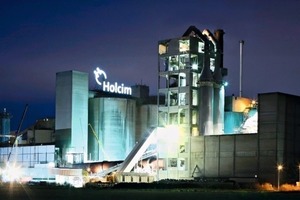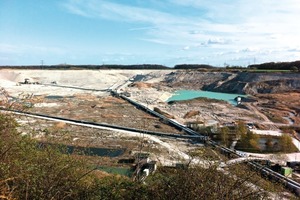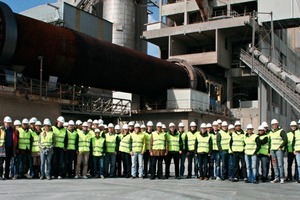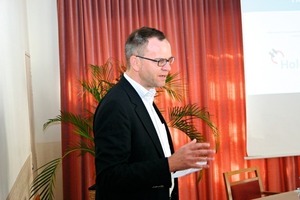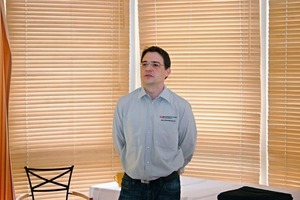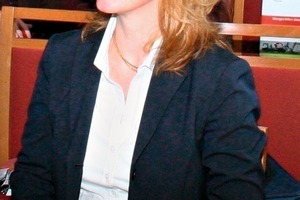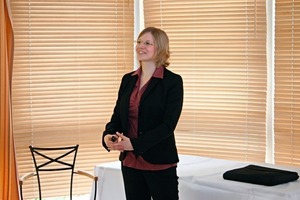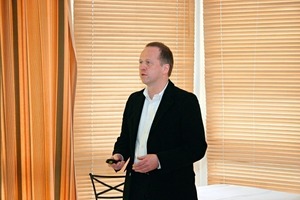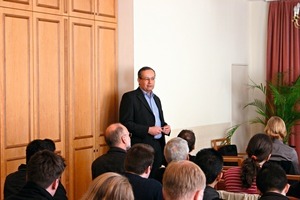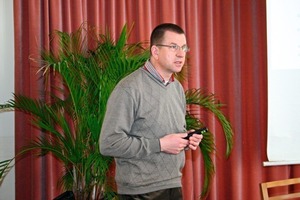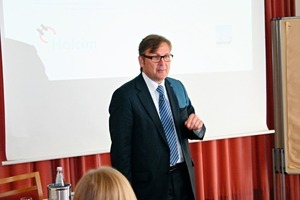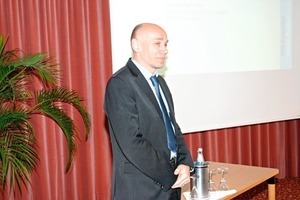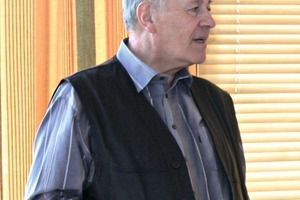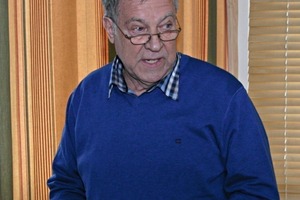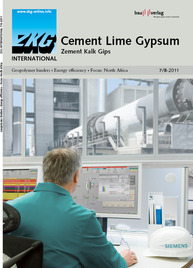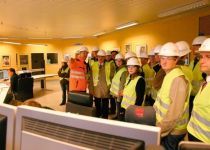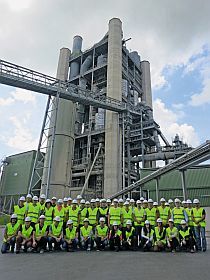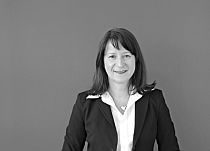Modern cement production with a high substitution rate
ZKG Technical Excursion 2011, Höver/Germany (13.–14.04.2011)
From 13th to 14th April 2011, ZKG INTERNATIONAL together with Holcim’s Höver cement works (Fig. 1) invited 50 students from Hamburg University to introduce interesting fields of activity to students from the faculties of process engineering and machine building. This time the event was supported by Holcim (Deutschland) AG with the Höver works group headed by the works manager Marius Seglias. Well-known machinery suppliers supported the event: The Christian Pfeiffer Maschinenfabrik GmbH, Aumund Fördertechnik GmbH, IKN GmbH Ingenieurbüro-Kühlerbau-Neustadt and KHD Humboldt Wedag AG.
After a short introduction by Christian Reinke, advertising manager of ZKG INTERNATIONAL, the lecture program was started. Two experienced employees from Holcim, Dr. Klaus Ellwanger and Helge Heinemeyer, presented the Höver cement works. At Höver the objectives have always been to further extend the economic and ecological competitiveness as well as the acceptance in the neighbourhood (see also the report on page 29) by means of continuous improvement and optimization. For example, Höver was the trailblazer in Germany as regards the conversion from ESP to bag filters. In 1998 the main filter was converted, in 2003 the bypass filter. Today the plant is distinguished by an environmentally friendly and highly efficient cement production with a fuel substitution rate of about 70 %.
After the presentation of the works, Jens Breidenbach, process engineer from KHD Humboldt Wedag GmbH, Cologne/Germany, talked about the profile of requirements of a turnkey plant construction company. Breidenbach, who works in the Pyro Process Engineering division of KHD, said at the beginning that the company had established good contacts during the last students excursion that still exist. Jens Breidenbach was supported by Corinna Bergemann, marketing manager EMEA/Russia at KHD. KHD offer plant equipment and engineering from the quarry to the packing plant. About 55 % of the plant equipment come from their own company, the rest will be purchased. Plant sections that can be designed with KHD equipment are, amongst others, raw material grinding, the pyro-processing system as well as finish grinding. In particular Breidenbach explained the processes in the core fields of KHD, e.g. the cyclone preheater operating according to the counterflow process. A special design of the highly efficient cyclones leads to a low pressure loss. The KHD precalciner can be supplied in various designs according to the requirements of the customer, for example, as an emission reducing LowNOx calciner or as a combustion chamber calciner - another, very flexible alternative for the combustion of at times even lumpy substitute fuels. The product portfolio of KHD includes two burners, the Pyrojet® and the Pyrostream® burner with capac-ities of up to 250 MW and lining lengths of up to 12 m, as well as two modern and efficient clinker coolers, the Pyrofloor® and the Pyrostep® units.
Following this, Eva Schneider and Jörg Hammerich presented the range of services offered by the company IKN. Originally this company manufactured coolers, however, due to the cooperation with PSP Engineering they also increasingly offer plant components, such as rotary kilns and preheaters. Another interesting aspect was the “paperless” management of international projects demonstrated by the example of an order in Iran. Since only a very few drawings and documents were submitted on paper, the project could be managed particularly quickly and efficiently. IKN also have special connections to the Höver works. There the company replaced the old planetary cooler by a modern grate cooler. To keep the downtime as short as possible, very detailed planning of all erection steps as well as the preassembly of individual plant components were required. The hot central air of approx. 400 °C of the grate cooler at Höver is taken to dry the granulated blastfurnace slag. Then Eva Schneider explained the requirements of the business to sell new plants and modernization projects. Only with careful pre-planning already during the design phase, alternatives can be considered and target-oriented decisions can be made. This is another prerequisite for the successful management of projects within an extremely short period, which is more and more frequently required.
Then Jürgen Lenze presented the product portfolio of the Beckum-based Christian Pfeiffer Maschinenfabrik (CPB). The company was founded in 1925 and they supply plant components, optimize existing plants and design new grinding plants. The job profiles for designers of ball mills were particularly interesting for the future machine builders and process engineers. Further technical developments made it possible that, for example, for some years material handling has been feasible even outside the airflow due to the transfer diaphragm between the coarse and fine grinding compartment. Lenze underlined the increased portion of composite cements and the related increased requirements as regards mill linings and ball charges. Then he outlined the separation technology. The finished product can be separated from the separating air by means of cyclone separators or a process filter. Furthermore, the latter option makes it possible to significantly reduce the cement temperature by feeding in fresh air. Alternatively there is also the possibility to achieve this by a powder cooler from CPB that operates in counterflow and conserves materials. In another part of his lecture Lenze dealt with projects implemented in the UAE, Russia, the Ukraine and Romania. In 2010 CPB successfully installed a complete turnkey grinding plant including the high-capacity separator QDK 33-NZ for Wotan Zement in Germany. In this case the special challenges were the limited space available, a plant situated on a hillside location, strict legal restraints as regards noise emissions as well as the site in a drinking-water protection area. In the Wotan plant granulated blastfurnace slag, clinker and admixtures are ground jointly. The moist granulated blastfurnace slag is pre-dried in a separate plant with fluidized-bed drier. The development at CPB is continued without interruption both as regards the optimization of existing machines and components and also the development of new machines.
Concluding the technical section, Reiner Furthmann, technical manager of the Rheinberg-based Aumund Fördertechnik GmbH, briefly presented the product portfolio for the cement industry. He was supported by the marketing manager Jens Kellersmann. Aumund sees their strength in the discharge of difficult bulk solids. Furthmann explained clearly the link between industrial requirement profiles and bulk solids mechanics in the light of various process components. Selection criteria for discharge systems are basically the properties of the bulk solids, the shape of the silos or bins as well as the process engineering requirements. Demonstrated by the example of apron conveyors, belt conveyors or continuous-flow conveyors as well as special discharge devices with discharge wheels, he showed the interdependence of plant technology and properties of bulk solids and according to which criteria the optimum discharge system should be selected.
Finally, Gerald Gibalowski, personnel manager of the Höver works, explained how a possible career start at Holcim might look. Using the example of the various ways of qualification at the works he demonstrated the demands made on the applications, interviews and the appointment of possible employees. They are always looking for active and competent employees for technically exacting and interesting tasks, for example also in advertisements in this issue on pages 88 and 89.
Between the lectures, participants had the opportunity to combine the theoretical information of the lectures with practice within the framework of a plant tour through the Höver works. The plant was shown to the participants in two groups. From the raw material supplied from the quarry (Fig. 2) and the preheater tower and the kiln plant to the finish grinding mill and dispatch, all process steps were visited under the competent direction of Dr. Ellwanger and Mr Heinemeyer. There was plenty of time for interested questions and for consolidation of what they had heard (Fig. 3).
This year also Prof. Dr.-Ing. Martin Geweke and Prof. Dr. Ing. Theodor Hesse from the Hamburg University of Applied Sciences (HAW) supported the organization of the excursion and accompanied it. Thus, many questions could already be answered directly during the lectures, forging a link between the industrial application and what is taught in the lectures at the university. The lecturers clearly stated that in addition to professional competence, most of all, the readiness to travel throughout the world is required in a globally positioned environment. Together with the lecturers, participants had the opportunity to intensify what they had heard and to compare it with the university material through very active and, most important, interactive communication both during and following the lectures.

